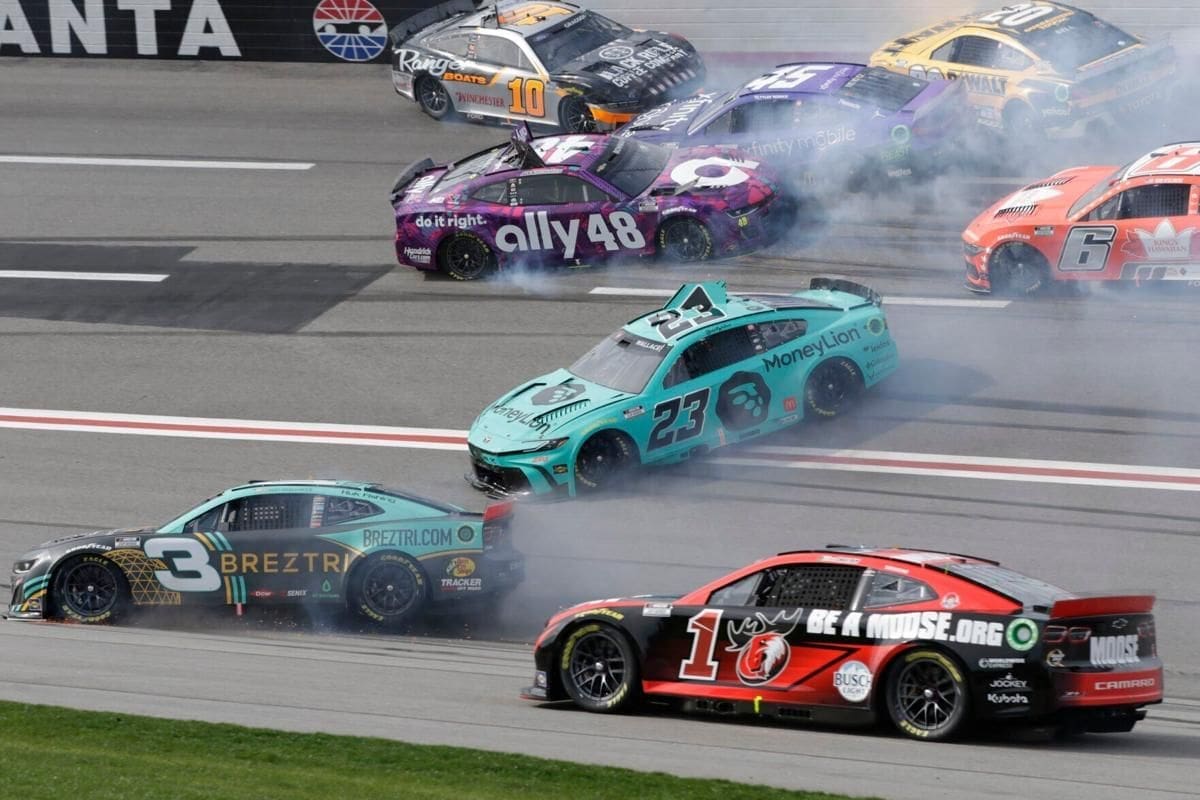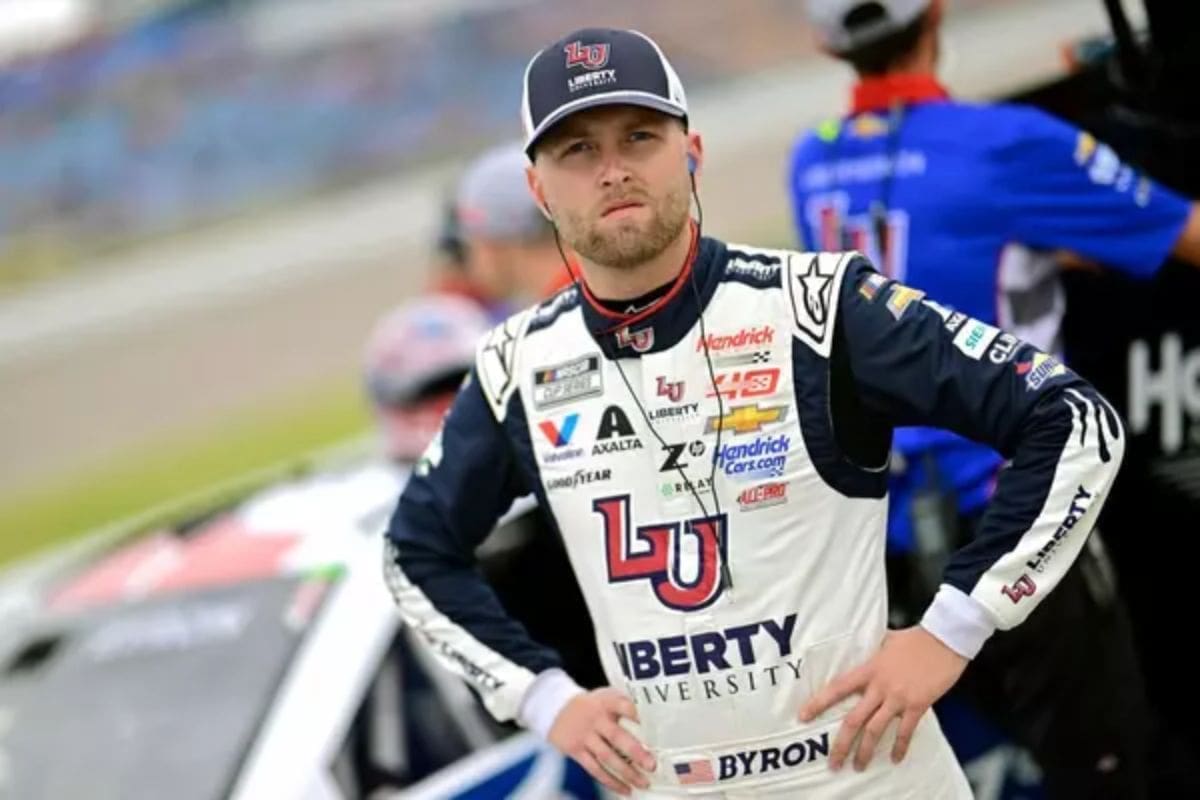William Byron and Brad Keselowski’s Terrifying Crash: The recent crash involving William Byron and Brad Keselowski at Watkins Glen serves as a clear reminder of the inherent dangers present in NASCAR, where split-second decisions can lead to catastrophic outcomes. Byron’s ill-fated attempt to execute an outside pass not only resulted in a collision but also raised questions about the drivers’ judgment under duress. While both drivers escaped without injury, the incident has broader implications for race strategies and the psychological toll on competitors.
Key Highlights
- William Byron’s aggressive outside pass attempt on Brad Keselowski resulted in a high-speed collision at Watkins Glen.
- The crash occurred during a turbulent race marked by early wrecks and unpredictable track conditions.
- Both drivers emerged unscathed, showing the effectiveness of modern safety technology in NASCAR.
- Byron’s crash caused significant vehicle damage, forcing a costly pit stop and dropping him to 34th place during overtime.
- The incident altered competitors’ strategies, intensifying the already unpredictable nature of the race.
The Crash Incident
The intensity of competition in the NASCAR Cup Series often leads to moments of high tension and unpredictability, exemplified by the crash incident involving William Byron and Brad Keselowski at Watkins Glen. This incident unfolded in the latter stages of the race, showcasing the inherent risks associated with aggressive driving strategies in high-stakes environments.
As the race progressed, Byron, piloting his No. 24 car, initiated an outside pass on Keselowski’s No. 6 vehicle. This action was precipitated by a preceding contact involving fellow driver Joey Logano, which served to heighten the competitive dynamic on the track. In attempting to gain an advantage, Byron miscalculated the spatial dynamics, leading to a catastrophic sequence of events. His car climbed over the back of Keselowski’s vehicle, with the right front wheel dangerously positioned within Keselowski’s driver window.
OH MY GOODNESS!
WILLIAM BYRON AND BRAD KESELOWSKI CRASH! #NASCARPlayoffs pic.twitter.com/Uf3mAHGyCn
— NASCAR on NBC (@NASCARonNBC) September 15, 2024
The aftermath was a violent collision, as both cars collided with the wall at high speed, illustrating the perilous nature of racing at this level. Remarkably, despite the severity of the crash, both drivers emerged from their vehicles, emphasizing not only the advancements in safety technology in NASCAR but also the resilience of the athletes involved.
Race Conditions and Impact
Amidst the chaotic atmosphere at Watkins Glen, the race conditions considerably influenced the participants’ strategies and outcomes. From the outset, the race was blemished by early wrecks beginning on Lap 1, which set a turbulent tone that would reverberate throughout the event. The unpredictable nature of the track, coupled with the high-stakes environment, forced drivers to adopt aggressive and adaptive strategies, often prioritizing immediate gains over long-term race plans.
For William Byron, the crash involving Brad Keselowski was not merely a singular event but a catalyst that altered his path for the entire race. Sustaining severe damage to his vehicle, Byron faced an urgent pit stop that not only cost him precious time but also pushed him to the back of the field, restarting in position 34 during overtime. This repositioning exemplified the impact of race conditions on individual drivers, where a single incident could derail an entire strategy.
The consequences of this chaotic landscape extended beyond Byron, affecting other competitors who had to navigate the heightened risks. Drivers were forced to recalibrate their approaches, weighing the potential benefits of aggressive actions against the ever-present threat of another incident.
Byron’s Performance Struggles
William Byron’s recent performance has been characterized by a disconcerting inconsistency, markedly deviating from the promising momentum he built at the beginning of the season. Initially regarded as a driver to watch, Byron’s path has taken a downturn, reflected in a series of lackluster finishes that stand in clear contrast to his earlier form. The driver has expressed frustration with these struggles, indicating that despite rigorous preparation, the results have been “across the board,” suggesting a pervasive issue rather than isolated incidents.
“I mean we’re certainly trying really hard. I feel like we’re preparing harder than we ever have. You know, I think we’ve just been a bit across the board, all over the board, with results.” – Byron
Byron’s comments highlight a perplexing contradiction: while the team has shown competitive speed, particularly at tracks like Sonoma, the ability to capitalize on that performance has been undermined by unfortunate circumstances. The flat tire and subsequent wreck at Sonoma are indicative of the misfortunes that have plagued his season, preventing him from showcasing the potential inherent in his car.
“But if you look at the speed that we’ve had, Sonoma comes to mind as a race where we had top-three or four speed, but never really got to show that because we had a flat tire early and then got in that wreck with everyone in Turn 11.’” – Byron
This inconsistency raises questions about the underlying factors affecting performance—whether they stem from mechanical issues, tactical missteps, or external race conditions.
As the season progresses, Byron must grapple with these challenges, aiming to regain the form that once positioned him as a formidable contender. The comparison of speed and poor results necessitates a thorough analysis of both driving and team dynamics, as he and the crew seek to rectify their path.
Byron’s Focus on Playoff Points
Consistency remains a vital objective for Byron as he navigates the latter stages of the season, particularly with the playoffs on the horizon. His recent performances have been a mixed bag, leading to frustration as he works to solidify his standing. As he stated, achieving consistency is critical, and he has identified key areas for improvement to improve his playoff positioning.
“I just look at the results as a bit frustrating because we’ve been all over the board. But Iowa was a really good race for us, finishing second.”
“I feel like we just have to be able to show up week in and week out and put together those consistent weekends; communication-wise, effort-wise and limit the mistakes and just see where we are.” – Byron
To optimize his playoff bonus points, Byron must focus on several tactical components:
- Minimize Mistakes: Reducing errors during races will allow him to secure more favorable finishes.
- Effective Communication: Improving dialogue with his team can lead to better adjustments during races and a clearer game plan.
- Stage Wins: Targeting stage victories will not only strengthen his point total but also improve his confidence heading into the playoffs.
- Race Wins: Ultimately, securing race victories is vital for both points accumulation and momentum.
Byron’s recent second-place finish at Iowa highlights his potential when all elements align. He acknowledges that climbing the points ladder is fundamental, emphasizing the importance of consistent performances week in and week out.
“We’re trying to climb the points ladder – that’s important this time of year. Try to get as many bonus points as we can for the playoffs because of that seeding through the regular season standings.
“So, I just feel like if we can get that stage win, race win or advance up the ladder in the points, that’s really what the goals are right now.” – Byron
As the playoffs approach, every point counts, and his focus on achieving these goals will be instrumental in determining his success. With the right mindset and adjustments, Byron can transform his current frustrations into a competitive edge, positioning himself strongly for the upcoming challenges in the postseason.
News in Brief: William Byron and Brad Keselowski’s Terrifying Crash
The crash involving William Byron and Brad Keselowski at Watkins Glen serves as a clear reminder of the inherent dangers in NASCAR racing. The incident disrupted the race dynamics and raised questions regarding driver decision-making under stress. Additionally, the event highlighted the importance of safety advancements that allowed both competitors to escape unharmed. As the season progresses, the consequences of this collision will likely resonate through the strategies and performances of other drivers competing for playoff points.
ALSO READ: William Byron’s Title Hopes Fades: How Chase Elliott and Kyle Larson Outpaced Him



